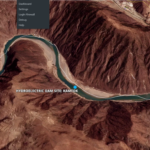Executive Summary
Rare protests against the construction of a new hydropower dam in Tibet that risks catastrophic impacts on the world’s highest and largest plateau and downstream in China have been met with violent paramilitary reprisals. The planned Kamtok (Chinese: Gangtuo) dam in the sacred mountains of Gèndong threatens the displacement of villages and ancient Buddhist monasteries in the upper reaches of the Drichu or Yangtze river (Jinsha in Chinese).
The protests draw urgent attention to China’s extractivist plans that are carving up the Tibetan landscape, risking landslides, earthquakes and food insecurity, and impacting tens of millions living downstream in China, India and elsewhere in Asia. State-owned conglomerates are accelerating the construction of mega dams and associated infrastructure in Tibet despite the inherent dangers of a seismically unstable region where river systems are increasingly unpredictable due to climate change.
For the first time, China’s dambuilding is now reaching upriver to the sources of Asia’s great wild mountain rivers in Tibet in landscapes that were previously among the least disturbed habitats on earth. Tibet is described by Chinese engineers as “the main battlefield of China’s hydropower construction”,1 while a Chinese chief engineer warned that the process of constructing a dam in the upper reaches of the Drichu river is like building “high-rise blocks on tofu”.
The construction of the Kamtok dam is a central government plan being carried out by Chinese state-owned company Huadian, one of the world’s biggest coal-fired carbon emitters which signed a strategic partnership agreement with Germany’s Siemens last month and has assets and businesses established in countries involved with China’s Belt and Road Initiative.
The plans involve the entire population of the area – monks and lay, old and young – being uprooted and displaced in their thousands from villages and monasteries that have flourished upstream in the sacred mountains of Gèndong alongside the Drichu2 or the upper Yangtze River, the longest and largest river on the Eurasian continent.
Paramilitary forces have imposed a lockdown after February protests in the Derge area of Kardze (Chinese: Ganzi) in Sichuan (the Tibetan area of Kham) against the construction of the 1.1 million kilowatts hydroelectric dam.
Even Chinese scholars and Chinese Communist Party (CCP) officials have underlined the importance of monasteries with “invaluable” 14th century CE Buddhist frescoes of “artistic splendour” that survived the Cultural Revolution but are now threatened with demolition and the displacement of hundreds of monks.
Video footage providing a rare glimpse of the situation in the area documented a peaceful gathering of Tibetans outside the county government headquarters in Kardze on 14 February, appealing for dam construction to be stopped. Just over a week later, teams of county officials and police arrived at two monasteries in Wonpotoe Township (Chinese: Wangbuding) to prepare for demolition. Footage sent out of Tibet – despite the extreme danger of doing so – showed the abbot of a monastery and elder Tibetans on their knees, crying and appealing to officials to stop the dam project and not remove them from their land. Other videos show monks being encircled and detained by police. Tibetan protesters were beaten so badly they were injured and hospitalised, and hundreds detained, with some facing criminal charges.
Party officials have now warned Tibetans that the massive hydro project on the upper reaches of the Yangtze – a river that is known downstream as an important cradle of Chinese civilisation – will go ahead regardless. The development reverses an order in 2009 by China’s Environment Ministry to Huadian Corp to suspend “illegal” construction of dams in the middle reaches of the Yangtze in Tibet because of environmental concerns.
The construction of the Kamtok dam risks a cascade of adverse consequences both on the plateau and in China, serving as a reminder that China’s policies in Tibet – where water is regarded as a ‘strategic asset’ by the Communist Party state – affect global climate systems already challenged by food and water insecurity involving glacial melting and erratic monsoon cycles. A leading Tibetan professor based in Beijing has revealed data showing that the rivers of Tibet are becoming more and more unpredictable.
As a storehouse of freshwater and the source of the earth’s eight largest river systems, the Tibetan plateau – a global climate change epicentre – is a critical resource for the world’s 10 most densely populated nations surrounding it. But China has accelerated implementation of detailed plans to steadily move dam building upriver into steeper terrain.
On a visit to Sichuan last July, Xi Jinping underlined China’s priorities in using the Tibetan plateau as major extraction zones for water, electricity and lithium, urging provincial officials “to write a new chapter in advancing Chinese modernization”.4 The completion of the world’s highest altitude high-voltage power grid in 2018,5 linked to the construction of a fully electrified high speed rail line from Chengdu in China’s Sichuan Province to Lhasa,6 demonstrates the CCP’s demand for hydropower-based energy resources and plans to intensify infrastructure construction in Tibet.
Now, these long-term plans focus on connecting hydro in the upper reaches of Asia’s wild rivers with extraction of solar energy, windpower, hydropower, lithium, copper, gold, silver and molybdenum. China already leads globally in PV (photovoltaic) solar, wind turbines, hydro dam construction and the power grids that connect them to distant industrial users. It also fulfils a nation-building agenda, establishing Chinese uses for Tibetan landscapes and rivers, just as China seeks to break and reshape Tibetan inner landscapes, eradicating a separate sense of identity and history and compelling compliance with Chinese cultural nationalism.
China’s plans involve raising captive water levels high enough to lap at the bottom of the dam wall of the next dam upriver, with most of the scheduled construction on the Dri Chu (Jinsha, upper Yangtze). This is a cascade, a series of pondages that reduces a racing mountain river to a chain of man-made lakes, each positioned exactly to butt up against its upriver neighbour. This plan requires dam walls that will be among the highest dam walls worldwide, as much as 300-400 metres high. At worst this risks a chain reaction as dams successively fail, causing the next to fail too, swept away by a tsunami wall of water 12 metres high.
In 2018, construction work on another massive dam in Tibet, the Lawa Batang dam over the Drichu river in the Tibetan area of Kham, was held up by a massive landslide, an entire mountain face rushing into the Drichu/upper Yangtze with such speed and force that one of the world’s great rivers was stopped. Then, as waters banked up behind the natural dam, the dam broke. Thousands of houses collapsed and roads and infrastructure destroyed.
The sheer scale of dam construction heightens the risks. Dam-building raises the water level of rivers which increases the pressure of the water on the ground, which in turn increases the number of geological catastrophes especially since the valleys of the Himalayas are so young, its river still incising. Seismic waves caused by earthquakes can shake dam walls from unexpected angles, turning concrete and rock to tofu in a moment.
Although the hydro dams in the steep valleys of the eastern Tibetan mountains are described as clean and green energy, their construction involves carbon emissions generated from processing and transport of fossil fuel-intensive raw materials. Building the high walls of the dams requires importing vast amounts of cement made by fossil fuel burning, blasting rock from nearby steep valley walls, trucking and compacting those rocks as the fill comprising most of the weight of a wall intended to hold back the world’s great rivers.
As well as affecting people downstream in China, the dam building shift upriver into Tibet also impacts farmers and fisherfolk down river in Cambodia, Vietnam, Thailand, Laos and Myanmar. This is linked to the announcement last year of a major hydro dam near Markham (Chinese: Mangkang) in Kham Sichuan on the Za Chu/Mekong/Lancang Jiang in Tibet built by China’s Huaneng, one of the big five state-owned power corporations providing electrification for China.
The announcement of relocation in Derge comes at the same time as monks were being forced to comply with orders to relocate from another monastery in Tsolho, Qinghai. Similar footage emerged from Tibet of Tibetans appealing to officials against relocation to make way for construction of a new hydropower project that is underway on the Machu (Yellow) River. The massive construction project involves the destruction of the 19th century monastery of Atsok, rupturing the Tibetan community and its spiritual centre. Before issuing orders to relocate, affecting around 15,000 Tibetans, Chinese authorities announced the removal of Atsok Monastery from the list of recognized cultural and historical sites in the county.


